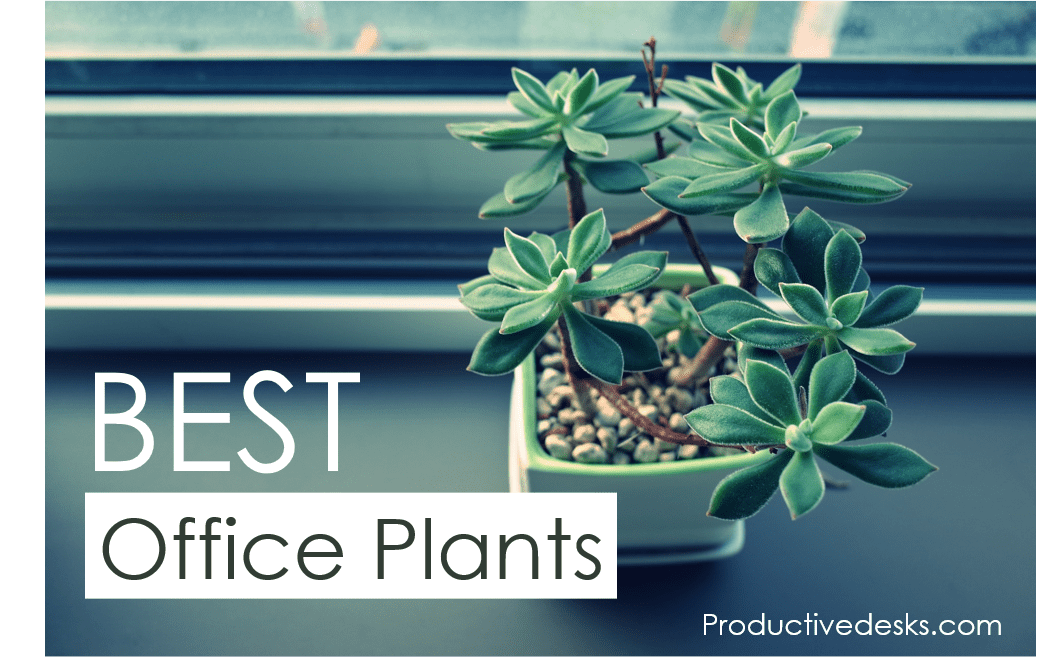In this article, you will know :
>>>Related: How To Keep Your Desk Clean All Year Long
Benefits Of Office Plants
Why Are Plants Good For The Office?
What most people don’t know is that the benefits of indoor plants in the office run deeper than just aesthetics. Nowadays, companies make sure to incorporate more greenery in the workspace design because they know how important it is.
1. Plants make the workspace visually appealing and more attractive
A workspace filled with greenery is definitely not like a space that isn’t. Either at home or the office, plants offer a visually meditative experience that, ultimately, leads to happier and healthier life.
An office teeming with vibrant greenery will also convey a positive brand image to visitors.
2. Office Plants reduce stress
The green color symbolizes nature and the natural world. It is often used in decorating for its calming effect.
Studies have shown that green relieves stress and help to heal. Those who have a green work environment experience fewer stomachache. Therefore, office desk plants contribute in reducing sickness and absence rates among workers.
3. Office Plants help reduce the noise
Plants are commonly used to reduce noise pollution along highways and interstates. Using the same concept, plants in the workplace change room acoustics by reducing reverberation time. Plants placed in areas with hard surfaces such as hardwood floors, concrete and marble walls, will effectively absorb noises which can be distracting and hurt one’s productivity.
4. Office Plants are natural air cleaners
Plants in the office improve air quality by removing harmful pollutants. Plants also stabilize humidity levels.
5. Office Plants increase productivity and boost creativity
Do plants increase productivity? Of course, they do!
Psychologists have found that, as well as oxygenating the air, bringing some flora into the workplace can improve employee satisfaction and can increase productivity by up to 15 per cent.
18 Best Indoor Office Plants
1. Chinese Evergreen (Aglaonema modestum)

Aglaonema, also known as Chinese Evergreen, is derived from two Greek words: ‘aglaos’ meaning bright and ‘nama’ a filament or thread, referring to the striking stamens produced within the flowers. For the Chinese people, it symbolizes long life (that’s why it’s called Chinese Evergreen).
Aglaonema is one of the most popular indoor plants. It makes a great office plant because it requires very little maintenance. It’s attractive, slow-growing, and thrive in low light while removing toxins from the air.
A very adaptive houseplant.
2. Devil’s Ivy (Epipremnum Aureum)

It’s an easy to care plant with heart-shaped leaves. It can adapt to different environmental conditions, so whether your desk receives low or brighter light, it will survive.
Devil’s Ivy requires very little maintenance. This plant doesn’t need a regular watering schedule and likes to dry out completely between waterings; when the leaves are drooping a little, it’s time for water. Don’t worry too much about fertilizing your ivy, as a monthly dose of regular houseplant feeder typically does the trick.
3. English Ivy (Hedera Helix)

English Ivy requires medium light and average water to thrive indoors. When you first start growing these vines you should water them frequently. Once they’re established, they can tolerate dry conditions. Even better: They do well in cooler temps.
If your desk is located in a space that lacks fresh air circulating, consider getting an English Ivy plant. They remove airborne particles and filter out formaldehyde.
4. ZZ plant (Zamioculas Zamiifolia)
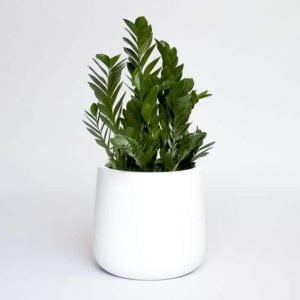
Some people don’t want to get a plant because they feel guilty about killing their previous plants. The ZZ plant is one of the most low-maintenance plants you can find. It can tolerate prolonged periods of low light, and its fat stalks and bulging roots store a huge amount of water.
So you don’t have to search around the office for a watering can every day. Two main characteristics that have helped it rocket in popularity around office areas and made it one of the best office plants for desks.
5. Weeping Fig (Ficus benjamina)

Ficus Benjamina is a very popular houseplant because of its tolerance of poor growing conditions.
It performs best in bright sunny locations but will also survive in shade. Therefore, whether your office is bathed in light or only offers filtered sunshine, this plant will survive. It’s just perfect!
6. Philodendron

These plants are easy to grow and adapt easily to most conditions. They can be moved around the office, inside and outside, and won’t show signs of distress.
Philodendron care is easy because if you watch for the signals, the plant will tell you exactly what it needs. Even inexperienced houseplant owners will have no trouble growing philodendron plants because the plants adapt readily to conditions inside the home.
7. Peace Lily (Spathiphyllum)

One of Peace Lily’s advantages is cleaning the air by removing toxins and creating a nicer environment in which to work.
Better yet, it can grow even in low office lighting; ideal for an office space that lacks big windows. And it likes humidity, so try to maintain moistness in the soil and keep it away from heaters and air-conditioning units.
8. Anthurium

Anthurium plants can tolerate low-light conditions, but in low light, they will have fewer flowers and will grow slower. It grows best in bright, indirect light.
It also requires that the soil be free draining but hold some water.
9. Cacti
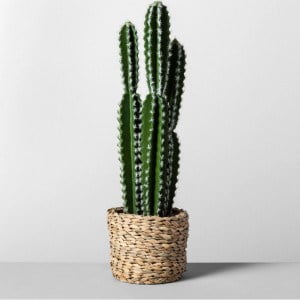
Cacti or Cactus plants only have to be watered once a week during the spring and summer, and every three weeks during the fall and winter.
Commonly found in dry, harsh deserts, the cacti plant is one of the only plants that actually thrive on neglect.
Cacti do prefer higher light levels, so if you are lucky enough to have a window desk they will thrive.
10. Snake Plant (Sansevieria Trifasciata)
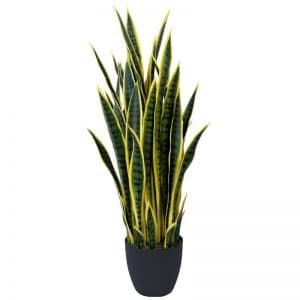
It grows in a vertical, compact fashion, reducing mess and taking up a neat corner on your desk or in your office.
When it comes to size, Snake Plants are different. It features stiff leaves that range from six inches to eight feet tall, depending on the variety. Some specimens can grow several feet high, so pick your size wisely.
Snake plants are perfect for houseplant newbies; they can survive low light levels and drought. You can simply dump your water bottle on it on your way out the door on Friday and enjoy this slow-growing desk plant.
11. African Violet

African violets are small houseplants that produce clusters of white, blue, or purple flowers over fuzzy leaves. They take up very little space, a beautiful addition to your office.
Although sufficient light is necessary for blooms, African violets aren’t picky about the source of that light, and a fluorescent lamp aimed at the plant will help them flourish.
12. Aloe Vera

Aloe plants can fit most desks. Not only they clean the air around you, but you can also use the gel inside to treat cuts, burns, and other purposes.
They are not difficult to grow. The most important component for it to thrive in light. If your desk is near a sunny window, then plant it and forget about it. You don’t have to worry about watering it very often, it’s actually worse to overwater these plants than to underwater them. Just give it a soak every week or two.
13. Oxalis

Depending on the color of leaves, the flowers can be white, yellow, rose colored or pink. The flowers grow on top of bare stems and are quite dainty, and thin, like the leaves.
Although they can take sunlight, it is not uncommon for the leaves to wither and drop off in the middle of summer.
14. Bamboo

Bamboo, another easy to grow desk plants.
They can be grown in soil or water. For those in soil, don’t use too much soil or fertilizer, less is more when it comes to bamboos.
Place them near indirect sunlight and away from air conditioners and heating sources.
Growers sometimes shape lucky bamboo stems into fun shapes like spirals, weaves, or even hearts. It symbolizes luck in many parts of the world.
15. Jade plant (Crassula Ovata)

Excellent houseplant for the office desk: it can survive in harsh indoor conditions, it requires minimal watering, and the dark green leaves don’t need as much light as other succulents.
This office plant is known in the Japanese folklore as the “money plant”, it is believed to attract money and prosperity.
16. Kalanchoe
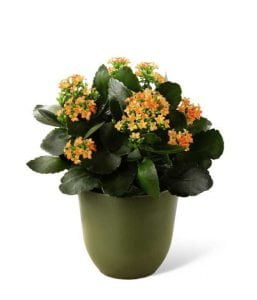
If you want a succulent houseplant that blooms, get a Kalanchoe.
Its warm and colorful blooms appear when the temperature warms up. Growing kalanchoe successfully is possible if you can place it in a well-lit position near a South or West facing window. Be sure to keep it out of any hot windows because it will burn.
17. Swiss Cheese, Monstera Deliciosa

This plant is very popular, chances are you’ve spotted its graphic leaves on pillows, wallpaper, mugs …
Monstera is a tropical plant from the Araceae family. Its name, as one might guess, comes from the Latin meaning “abnormal” because of its odd-looking, perforated leaves that are often punched through with holes.
18. Gerbera Daisy
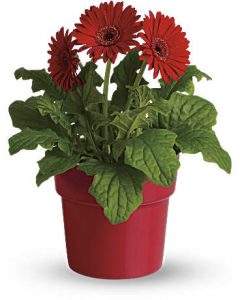
The Gerbera daisy is a type of Daisy originates in Africa. They are cultivated all over the world and known for their bright colors and a pleasant aesthetic.
Gerbera daisies are relatively simple to grow outdoors, but growing Gerbera daisies indoors can be tricky.
The plants, often given as gifts, are usually grown for a single blooming season before being discarded. However, if you can provide the right growing conditions, your Gerbera daisy may survive for two or three years.
This flowering plant, also known as Gerbera, is a plant that can filter toxins like benzene, a substance that can be emitted by some printing systems.
- Rubber Tree Plant
- Corn Plant
- English Ivy
- Aloe
- Bamboo Palm
- Peace Lily
- Parlor Palm
- Snake plant
- Boston Fern
- Cast Iron Plant
- Chinese Evergreen
- Philodendron
- ZZ Plant
- Jade Plant
- Areca Palm
How To Take Care Of Office Plants?
Office plant care is important, every specie requires special attention. We’ve mentioned some tips to take care of every plant individually. But there are some major points to pay attention to:
Lighting:
Lighting is also one of those things that can make-or-break your plant’s natural growth. Some plants need little light and others require bright light. If your office plant needs light, put it near a window, but not too close because intense, hot sunlight will scorch most plants. If you don’t have a window, a fluorescent light near the plant is the next best thing.
Watering:
When it comes down to it, water is definitely the key to keeping any plant happy and thriving. However, without proper research of the plant itself, it’s so easy for people to want to dump a cup of cold water in their pots and just call it a day.
Before you head over to the communal sink, remember to use lukewarm water for your plants. We know it can be tempting to douse your greens with ice cold water when the soil is looking especially dry, but it can actually do more harm than you think! After all, warm roots are important when it comes to growth. Lukewarm water should also help mimic humid temperatures since most plants thrive in humidity anyways.
You can also prevent overwatering by not watering your potted friends if you see that the soil is still moist from before.
Too much water or not enough water can be harmful to the plant.
Pot:
You’d never guess that the pots housing your indoor plants can have an effect on their health and growth, but they definitely do. Size, especially, matters. Pots that are too big for the plant can actually make its roots rot, while pots that are too small can cause the soil to dry out too quickly, stunting the plant’s growth – yikes!
The material of the pot can also have a say on your plant’s overall health. Plastic pots actually retain more moisture, which means you can water less frequently. Terra-cotta pots are more porous, which means you should water the plant more frequently, but they work well for plants that thrive in dry soil – like succulents and orchids!
If you’re afraid of the leakage, “double potting” will help with proper drainage by catching any extra water.
Additional Care Tips:
> Place your plant away from air conditioners, heating vents or drafty windows.
> Ask a friend or co-worker to take care of your plant if you’re sick or on vacation. Some plants can tolerate a certain amount of neglect, but too much may kill them.
> Fertilize desk plants every other month during spring and summer using a general purpose, water-soluble fertilizer. Always water after fertilizing to prevent damage to the roots.
> Transplant desk plants when they get too large for their pots – usually every couple of years. Move the plant to a container just one size larger. It may seem like a good idea to move the plant to a larger pot, but all that damp potting mix can rot the roots and kill the plant.
Final Thoughts
Office plants help sharpen your focus, improve your health, and purify the air. Having a plant in a room for just one day can remove up to 87% of toxins!
The Biophilia hypothesis suggests that humans possess an innate tendency to seek connections with nature and other forms of life. So, get a desk plant and enhance your connection with nature. It feels absolutely good!
Which office desk plant do you prefer? If you already have one, we would love to know your tips to take care of it during a busy workday.

